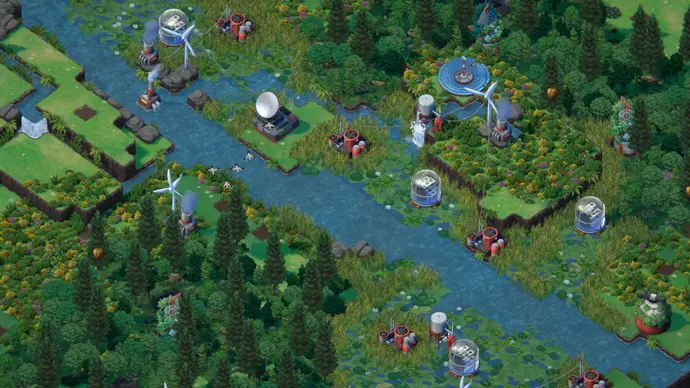
Terra Nil’s initial level has an almost flawless feel to it. When faced with the challenge of transforming a desolate quarry into a vibrant ecosystem, you begin small since what you give to the earth and what you take from it both replenish each other. You tend to little patches of land, funded by the irrigators you install to reestablish the grass on top of them, instead of following the norm of city builders who lay out your infrastructure extensively. One wind turbine and a few toxic scrubbers clean the soil one at a time.
After laying the groundwork, the next step is to restore the area’s wetlands, forests, and fynbos. When you turn an irrigator into a hydroponium and see it spread into wetlands, or when you plant a beehive and hear the brush of flowers and scrubland emerge, there’s something tactile and instantly fulfilling about it.
However, it’s made very evident that you aren’t zoning the area at will, unlike an architect or even a gardener. When I set off a controlled burn, I anticipate that it would just consume the flowers I have specifically targeted, but instead, the flames spreads to the margins of the sea and cliffs. Even while I can turn off the equipment that increases humidity to bring back rainstorms, salmon, and mosses, the rain clears the area more effectively than I could.
Once natural species have returned to their optimal homes and the biomes are in harmony, it’s time to recycle everything and leave nothing but a self-sustaining environment. Cleaning up afterward becomes an emerging’reveal’ of all I’ve worked on. Up until this point, it’s easy for me to lose sight of the big picture since I concentrate on little groups of buildings, lowlands, and hills. Additionally, before proceeding to the next level, as the camera softly sweeps over the newly created environment, you have the choice to “Appreciate” it.
The initial zone strikes a perfect mix between a calm and deliberate progression and a laid-back vibe. The subsequent levels, however, exchange that smoothness for exploration as they get more complicated and challenging. There are four distinct areas in all, along with unlocked endgame maps, and each has its own distinct difficulties, gameplay, and graphics.


Later stages of Terra Nil feature a more ‘puzzle’-shaped region where it’s possible to locate the incorrect answer first. Despite not being a very challenging game, there is a noticeable increase in the amount of lateral thinking that is necessary. I was taken aback to discover that I’d put myself in a situation where I had to redo sections of the map, at times the entire thing. I could create biomes and clean the soil, but not enough to get past a certain stage. Alternatively, I just ran out of resources, albeit in “zen mode,” that feature may be disabled. The ‘aha’ moments that follow and the opportunity to play detective more than make up for the unexpected.
Since biomes have requirements, and prerequisites can have prerequisites, the potential for lateral thinking expands dramatically. Perhaps a specific structure shouldn’t be placed here because of the low humidity, but installing cloud seeders near my natural water supplies won’t have a significant enough effect. I could construct on little ocean islands or channel out further, but doing so would decrease the amount of land available for other biomes. Moreover, it could always turn out that increasing the humidity today would make it difficult to place a new structure later. It’s a network of problem-solving and a fragile ecology.
The new dynamics in each zone do make for some very fantastic moments of enjoyment. For example, in the arctic, you begin by excavating hot lava fissures, which inadvertently elevates the surrounding temperature. All of the snow on the map melts when the temperature rises above zero, exposing previously unreachable soil. Later on, you have to turn the lava into rock, which lowers the temperature. When the humidity and toxicity are just perfect, new snow starts to fall again, clearing the ocean and any exposed soil that may still be there. These kinds of incidental, emergent moments occur on every map, and they are invariably powerful.


There are instances of less fluid sensations to counterbalance these moments of awe. For instance, a large number of your biome structures are made from recycled toxic scrubbers or irrigators. However, because the user interface advises you to use them sparingly at first, it seems wasteful to just set new, inefficient orange tiles down for recycling purposes. It’s as though I’ve just learned about recycled pallet furniture and am now going to eBay to purchase new wooden pallets.
In certain instances, like the monorail system that recycles its immediate surroundings while transporting items from land to the water, it may also become too click-y. To say the least, having an ergonomic mouse made me happy when I built a monorail network to recycle every building on the map and then gave the order to recycle 20 or 30 nodes individually (in order, so you don’t destroy the network).

Considering how much of Terra Nil’s design is focused on ecology, I have one major complaint: during the course of the game, the lack of people becomes obvious rather than confusing. The story explicitly states that there is nowhere on Earth for you, and it is made plain that the scenario is a post-climate disaster. Every level has a joyful conclusion that is your departure. Since a large portion of its gameplay is on sustainability—renewable growth and consuming no more than is given—imagining that this is only feasible in an ecosystem in which people have vanished feels contradictory and fatalistic.
I like that Terra Nil is making these bold, innovative decisions, even if I don’t always agree with them. Beyond just what its name would appear to imply, Terra Nil delivers captivating riddles, a deep dedication to the idea of what an environmentally conscious city builder would resemble, and lingering moments of pure bliss.